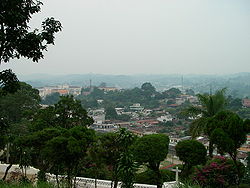Cobán
|
Cobán Kob'an (Q'eqchi' language) |
|
|---|---|
 |
|
| Location in Guatemala | |
| Coordinates: 15°29′0″N 90°22′0″W / 15.48333°N 90.36667°WCoordinates: 15°29′0″N 90°22′0″W / 15.48333°N 90.36667°W | |
| Country |
|
| Department |
|
| Founded | August 4, 1543 |
| Government | |
| • Mayor | Leonel Chacón (PP) |
| Area | |
| • Total | 2,132 km2 (823 sq mi) |
| Elevation | 1,320 m (4,330 ft) |
| Population (2014) | |
| • Total | 250,675 |
| • Metro density | 97/km2 (250/sq mi) |
| Time zone | GMT -6 |
| Climate | Cfb |
Cobán, fully Santo Domingo de Cobán, is the capital of the department of Alta Verapaz in central Guatemala. It also serves as the administrative center for the surrounding Cobán municipality. It is located 219 km from Guatemala City.
In 2014, the population was estimated at 250,675 inhabitants. The population of the municipality, which covers a total area of 1312 km², was approximately 94,000 people in 2005. Cobán, at a height of 1320 m above sea level, is located at the center of a major coffee-growing area.
Between 1530 and 1531, captain Alonso de Ávila on his way to Ciudad Real accidentally discovered the lagoon and hill of Lacam-Tún. People of that place had historically traded with all the people that the Spaniards had conquered and knowing what was coming, sought refuge in the jungle. The Spaniards tried in vain to conquer the lacandones: from Nueva España Juan Enríquez de Guzman tried; from the Yucatán Peninsula tried Francisco de Montejo; Pedro de Alvarado attempted it from Guatemala along with captain Francisco Gil Zapata and, finally, Pedro Solórzano from Chiapas. That is when the Order of Preachers tried to convert the Tezulutlán "War Zone" into a peaceful region.
In the meantime, after a series of setbacks in La Española, the island Audiencia allowed Bartolomé de las Casas to accept Friar Tomás de Berlanga invitation to go to Nueva Granada in 1534, where he had just been appointed as Bishop. Both sailed toward Panamá, to then continue to the city of Lima, but during the trip a storm tossed their ship to Nicaragua, where Las Casas chose to remain in the Granada convent. in 1535, he proposed to the King and the Council of the Indies to start a peaceful colonization of the unexplored rural zones in the Guatemala region; however, in spite of Bernal Díaz de Luco and Mercado de Peñaloza intentions to help him, his suggestion was rejected. In 1536 Nicaragua governor, Rodrigo de Contreras, organized a military expedition, but Las Casas was able to postpone it by a couple of years after he notified queen Isabel de Portugal, wife of Carlos V. Given the authorities hostilities, Las Casas left Nicaragua y went to Guatemala.
...
Wikipedia

